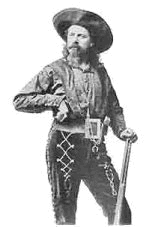25 to 30mm figures run in terms of scale from about 1:72 (meaning a 1 inch tall mini represents a 72 inch/6 foot tall person) to 1:60 size, and unless you're a real stickler for detail and accuracy, or try standing a 25mm cowboy next to a 30mm bandit, the sizes are basically interchangeable.
The closest widely available model train scales for these figures are S Scale (1:64 scale) or OO gauge (1:76 scale) which are more common in the UK than here in the states, but with the ease of online shopping you can probably find whatever you need at a reasonable price.
Some of the terrain and scenery pieces (trees, rocks, etc) from the ubiquitous HO Scale (1:87) that every american toy store carries might be compatible; but the trains themselves, buildings, people and animal figures will look rather small compared to your minis. Conversely, O Scale pieces (1:43 to 1:48) will tend to look pretty large compared to your figures, but again, some of the natural terrain and scenery bits will be useful. The reason I mention these is that HO and O Scale tend to be a lot more common in the US than S Scale or OO gauge, so finding things cheap in local shops will be easier.
When in doubt, my trick is to "rubber band" a mini of the size you prefer (and probably one you don't mind losing or damaging) to my keychain or run the keyring through its legs. This way, if I happen upon a toy/hobby/craft store or I'm hitting the local flea markets or goodwill type thrift stores and find a cool piece, I can hold one of my actual minis up to it and see if it will be a good fit for my collection.
Keep an eye out around, and especially after, the holidays for some of those holiday/christmas village pieces when they go on sale. Dollar stores are starting to carry a lot of these things too, and using the keychain mini trick above, you can quickly judge for yourself whether a building, set of 'civilians' people.
Don't be afraid to browse the aquarium section at your local pet store, Walmart or Target type superstore, or even dollar store. While the scale of fish tank decor pieces varies WILDLY, and the pieces are often painted crazy neon colors, our handy keychain mini trick and a quick touch up with some model paints could lead to some interesting pieces. This is also a great place to pick up nice sized bags of gravel to spice up a desert or badlands scene, just look for the natural sand colored stuff, or another color that fits your collection (red or black gravel mixed in with the natural stuff could make an interesting volcano or burned out building or mine scene, for example).
Also, hit up your local craft store now and then. Michael's is the big chain, but most decent sized towns have a similar place, and walmart type superstores and dollar stores often carry craft kits too. With a couple dollars worth of toothpicks or popsicle sticks and a cheap bottle of glue, you can quickly construct your own buildings, fences, mine details, etc. Better yet, you control the scale!
Craft stores also often have a good selection of affordable wooden or plastic model kits, including "old fashioned" wagons, buildings, boats, etc. Just remember to take your keychain mini with you, since these kits usually don't have the precise scale listed on the packaging.
Craft, hobby and superstores are also a good place to pick up decent paints, brushes, "hobby knives" (like Exacto blades or whatever) and other supplies you might want. Although the quality might not be quite that of the "professional" stuff you'll find at game stores or specialty vendors, the prices will be far lower.
Most importantly, get creative!
Also, hit up your local craft store now and then. Michael's is the big chain, but most decent sized towns have a similar place, and walmart type superstores and dollar stores often carry craft kits too. With a couple dollars worth of toothpicks or popsicle sticks and a cheap bottle of glue, you can quickly construct your own buildings, fences, mine details, etc. Better yet, you control the scale!
Craft stores also often have a good selection of affordable wooden or plastic model kits, including "old fashioned" wagons, buildings, boats, etc. Just remember to take your keychain mini with you, since these kits usually don't have the precise scale listed on the packaging.
Craft, hobby and superstores are also a good place to pick up decent paints, brushes, "hobby knives" (like Exacto blades or whatever) and other supplies you might want. Although the quality might not be quite that of the "professional" stuff you'll find at game stores or specialty vendors, the prices will be far lower.
Most importantly, get creative!

